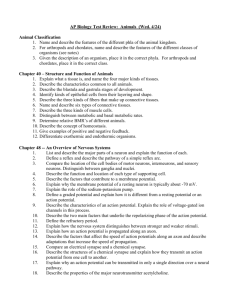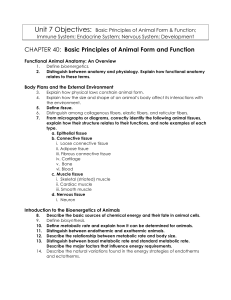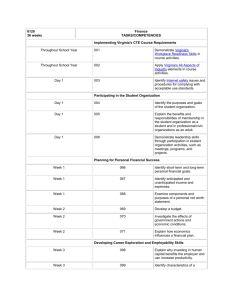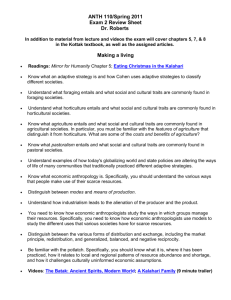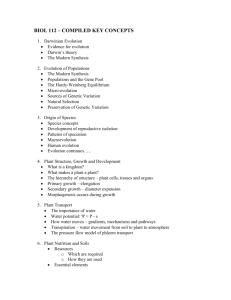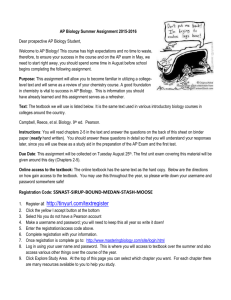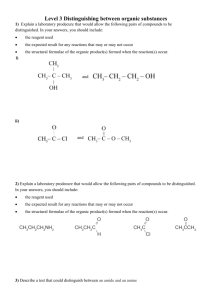U7_Obj_AnimalForm-Funct
advertisement
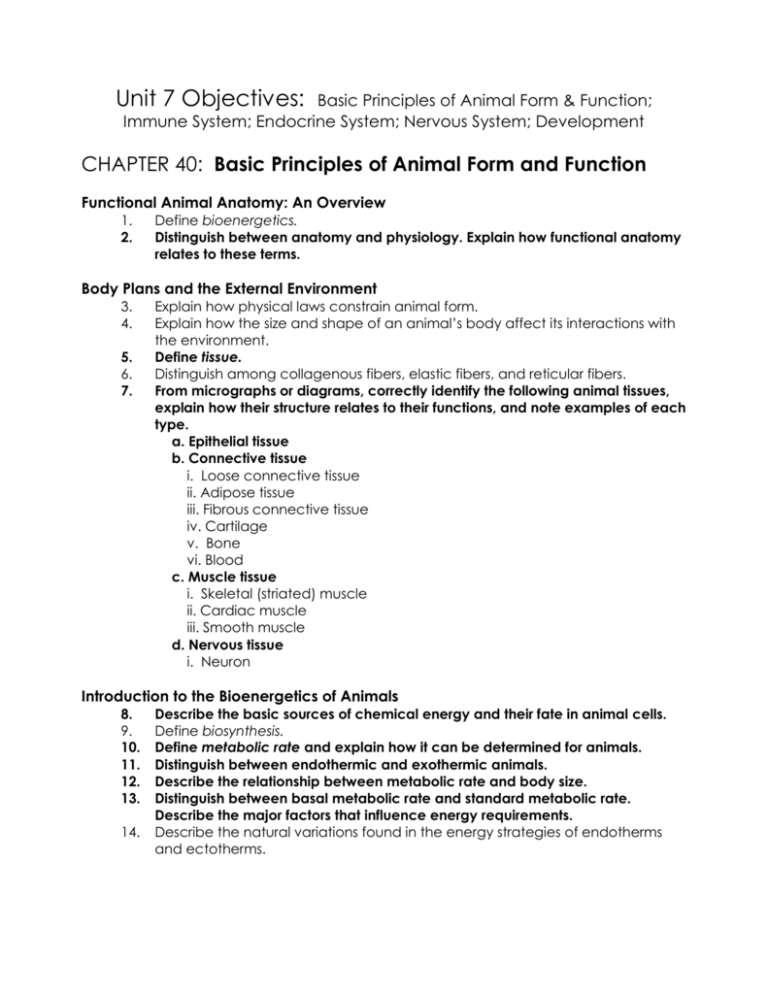
Unit 7 Objectives: Basic Principles of Animal Form & Function; Immune System; Endocrine System; Nervous System; Development CHAPTER 40: Basic Principles of Animal Form and Function Functional Animal Anatomy: An Overview 1. 2. Define bioenergetics. Distinguish between anatomy and physiology. Explain how functional anatomy relates to these terms. Body Plans and the External Environment 3. 4. 5. 6. 7. Explain how physical laws constrain animal form. Explain how the size and shape of an animal’s body affect its interactions with the environment. Define tissue. Distinguish among collagenous fibers, elastic fibers, and reticular fibers. From micrographs or diagrams, correctly identify the following animal tissues, explain how their structure relates to their functions, and note examples of each type. a. Epithelial tissue b. Connective tissue i. Loose connective tissue ii. Adipose tissue iii. Fibrous connective tissue iv. Cartilage v. Bone vi. Blood c. Muscle tissue i. Skeletal (striated) muscle ii. Cardiac muscle iii. Smooth muscle d. Nervous tissue i. Neuron Introduction to the Bioenergetics of Animals 8. 9. 10. 11. 12. 13. 14. Describe the basic sources of chemical energy and their fate in animal cells. Define biosynthesis. Define metabolic rate and explain how it can be determined for animals. Distinguish between endothermic and exothermic animals. Describe the relationship between metabolic rate and body size. Distinguish between basal metabolic rate and standard metabolic rate. Describe the major factors that influence energy requirements. Describe the natural variations found in the energy strategies of endotherms and ectotherms. Regulating the Internal Environment 15. 16. 17. 18. 19. 20. 21. 22. 23. 24. 25. 26. Distinguish between regulators and conformers for a particular environmental variable. Define homeostasis. Describe the three functional components of a homeostatic control system. Distinguish between positive and negative feedback mechanisms. Define thermoregulation. Explain in general terms how endotherms and ectotherms manage their heat budgets. Name four physical processes by which animals exchange heat with their environment. Discuss the role of hair, feathers, and adipose tissue in insulation. Explain the role of vasoconstriction and vasodilation in modifying the transfer of body heat with the environment. Describe animal adaptations to facilitate evaporative cooling. Describe thermoregulatory mechanisms utilized by endothermic invertebrates. Explain how ectotherms and endotherms may acclimatize to changing environmental temperatures. Explain the role of heat-shock proteins in helping cells to cope with severe temperature changes. Define torpor, hibernation, estivation, and daily torpor. CHAPTER 43: The Immune System Nonspecific Defenses Against Infection 1. Explain what is meant by nonspecific defense and list the nonspecific lines of defense in the vertebrate body. 2. Distinguish between: a. innate and acquired immunity b. humoral and cell mediated response 3. Explain how the physical barrier of skin is reinforced by chemical defenses. 4. Define phagocytosis. Name four types of phagocytic leukocytes. 5. Explain how interferon limits cell-to-cell spread of viruses. 6. Describe the inflammation response, including how it is triggered. 7. Describe the factors that influence phagocytosis during the inflammation response. 8. Explain how the action of natural killer cells differs from the action of phagocytes. 9. Explain what occurs during the condition known as septic shock. 10. Describe the roles of antimicrobial proteins in innate immunity. How Specific Immunity Arises 11. Distinguish between antigens and antibodies. 12. Distinguish between antigen and epitope. 13. Explain how B lymphocytes and T lymphocytes recognize specific antigens 14. Explain how the particular structure of a lymphocyte’s antigen binding site forms during development. Explain the role of recombinase in generating the staggering variability of lymphocytes. 15. Explain why the antigen receptors of lymphocytes are tested for selfreactivity during development. Predict the consequences that would occur if such testing did not take place. 16. Describe the mechanism of clonal selection. Distinguish between effector cells and memory cells. 17. Distinguish between primary and secondary immune responses. 18. Describe the cellular basis for immunological memory. 19. Describe the variation found in the major histocompatibility complex (MHC) and its role in the rejection of tissue transplants. Explain the adaptive advantage of this variation. 20. Compare the structures and functions of cytotoxic T cells and helper T cells. 21. Compare the production and functions of class I MHC and class II MHC molecules. Immune Responses 22. Distinguish between humoral immunity and cell-mediated immunity. 23. Describe the roles of helper T lymphocytes in both humoral and cell-mediated immunity. 24. Describe the functions of the proteins CD4 and CD8. 25. Explain how cytotoxic T cells and natural killer cells defend against tumors. 26. Distinguish between T-dependent antigens and T-independent antigens. 27. Explain why macrophages are regarded as the main antigen-presenting cells in the primary response but memory B cells are the main antigenpresenting cells in the secondary response. 28. Explain how antibodies interact with antigens. 29. Diagram and label the structure of an antibody and explain how this structure allows antibodies to (a) recognize and bind to antigens, and (b) assist in the destruction and elimination of antigens. 30. Distinguish between the variable (V) and constant (C) regions of an antibody molecule. 31. Describe the production and uses of monoclonal antibodies. 32. Compare the processes of neutralization, opsonization, and agglutination. Immunity in Health and Disease 33. Distinguish between active and passive immunity and describe examples of each. 34. Explain how the immune response to Rh factor differs from the response to A and B blood antigens. 35. Describe the potential problem of Rh incompatibility between a mother and her unborn fetus and explain what precautionary measures may be taken. 36. Explain what is done medically to reduce the risk of tissue transplant rejection due to differences in the MHC. Explain what is unique about the source of potential immune rejection in bone marrow grafts. 37. Describe an allergic reaction, including the roles of IgE, mast cells, and histamine. 38. Explain what causes anaphylactic shock and how it can be treated. 39. List three autoimmune disorders and describe possible mechanisms of autoimmunity. 40. Distinguish between inborn and acquired immunodeficiency. 41. Explain how general health and mental well-being might affect the immune system. 42. Describe the infectious agent that causes AIDS and explain how it enters a susceptible cell. 43. Explain how HIV is transmitted and describe its incidence throughout the world. Note strategies that can reduce a person’s risk of infection. CHAPTER 45: Hormones & the Endocrine System An Introduction to Regulatory Systems 1. Compare the response times of the two major systems of internal communication: the nervous system and the endocrine system. 2. Explain how neurosecretory cells, epinephrine, and control of day/night cycles illustrate the integration of the endocrine and nervous systems. 3. Describe the organization of a stimulus, receptor, control center, efferent signal, and effector in a simple endocrine pathway. 4. Describe an example of a negative feedback loop in an endocrine pathway involved in maintaining homeostasis. 5. Explain why the neurohormone pathway that regulates the release of milk by a nursing mother is an example of positive feedback. Chemical Signals and Their Modes of Action 6. List the three major classes of molecules that function as hormones in vertebrates. 7. Name the three key events involved in signaling by vertebrate hormones. 8. Explain what changes may be triggered by a signal transduction pathway initiated by the binding of a water-soluble hormone to a receptor in the plasma membrane of a target cell. 9. Discuss how and why different target cells exposed to the same hormone may respond in different ways. 10. Describe the nature and location of intracellular receptors for hormones that pass easily through cell membranes. Explain how their role compares to the signal-transduction pathway noted above, and describe the changes they are likely to trigger within the target cell. 11. Explain the role of local regulators in paracrine signaling. Describe the diverse functions of cytokines, growth factors, nitric oxide, and prostaglandins. CHAPTER 47: Animal Development The Cellular and Molecular Basis of Morphogenesis and Differentiation in Animals 1. Describe the significance of changes in cell shape and cell position during embryonic development. Explain how these cellular processes occur. Describe the process of convergent extension. 2. Describe the role of the extracellular matrix in embryonic development. 3. Describe the locations and functions of cell adhesion molecules. 4. Describe the two general principles that integrate our knowledge of the genetic and cellular mechanisms underlying differentiation. 5. Describe the process of fate mapping and the significance of fate maps. 6. Describe the two important conclusions that have resulted from the experimental manipulation of parts of embryos and the use of fate maps. 7. Explain how the three body axes are established in early amphibian and chick development. 8. Explain the significance of Spemann’s organizer in amphibian development. 9. Explain what is known about the molecular basis of induction. 10. Explain pattern formation in a developing chick limb, including the roles of the apical ectodermal ridge and the zone of polarizing activity. 11. Explain how a limb bud is directed to develop into either a forelimb or a hind limb. CHAPTER 48: Nervous Systems An Overview of Nervous Systems 1. 2. 3. 4. 5. Compare and contrast the nervous systems of the following animals and explain how variations in design and complexity relate to their phylogeny, natural history, and habitat: hydra, sea star, planarian, insect, squid, and vertebrate. Name the three stages in the processing of information by nervous systems. Distinguish among sensory neurons, interneurons, and motor neurons. List and describe the major parts of a neuron and explain the function of each. Describe the function of astrocytes, radial glia, oligodendrocytes, and Schwann cells. The Nature of Nerve Signals 6. 7. 8. Define a membrane potential and a resting potential. Describe the factors that contribute to a membrane potential. Explain why the membrane potential of a resting neuron is typically around 260 to 280 mV. 9. Explain the role of the sodium-potassium pump in maintaining the resting potential. 10. Distinguish between gated and ungated ion channels and among stretch-gated ion channels, ligand-gated ion channels, and voltage-gated ion channels. 11. Define a graded potential and explain how it is different from a resting potential 12. 13. 14. 15. 16. 17. 18. 19. 20. 21. 22. 23. 24. 25. 26. or an action potential. Describe the characteristics of an action potential. Explain the role of voltagegated ion channels in this process. Describe the two main factors that underlie the repolarizing phase of the action potential. Define the refractory period. Explain how an action potential is propagated along an axon. Describe the factors that affect the speed of action potentials along an axon and describe adaptations that increase the speed of propagation. Describe saltatory conduction. Compare an electrical synapse and a chemical synapse. Describe the structures of a chemical synapse and explain how they transmit an action potential from one cell to another. Explain how excitatory postsynaptic potentials (EPSPs) and inhibitory postsynaptic potentials (IPSPs) affect the postsynaptic membrane potential. Define summation and distinguish between temporal and spatial summation. Explain how summation applies to EPSPs and IPSPs. Explain the role of the axon hillock. Describe the role of signal transduction pathways in indirect synaptic transmission. Describe the specific properties of the neurotransmitters acetylcholine and biogenic amines. Identify and describe the functions of the four amino acids and several neuropeptides that work as neurotransmitters. Explain how endorphins function as natural analgesics. Describe the roles of nitric oxide and carbon monoxide as local regulators. Vertebrate Nervous Systems 27. Compare the structures and functions of the central nervous system and the peripheral nervous system. 28. Distinguish between the functions of the autonomic nervous system and the somatic nervous system. 29. Describe the embryonic development of the vertebrate brain. 30. Describe the structures and functions of the following brain regions: medulla oblongata, pons, midbrain, cerebellum, thalamus, epithalamus, hypothalamus, and cerebrum. 31. Describe the specific functions of the reticular system. 32. Explain how the suprachiasmatic nuclei (SCN) function as a mammalian biological clock. 33. Relate the specific regions of the cerebrum to their functions. 34. Distinguish between the functions of the left and right hemispheres of the cerebrum. 35. Describe the specific functions of the brain regions associated with language, speech, emotions, memory, and learning. 36. Explain the possible role of long-term potentiation in memory storage and learning in the vertebrate brain. 37. Describe our current understanding of human consciousness. 38. Explain how research on stem cells and neural development may lead to new treatments for injuries and disease. 39. Describe current treatments for schizophrenia. 40. Distinguish between bipolar disorder and major depression. 41. Describe the symptoms and brain pathology that characterize Alzheimer’s disease. Discuss possible treatments for this disease. 42. Explain the cause of Parkinson’s disease.
